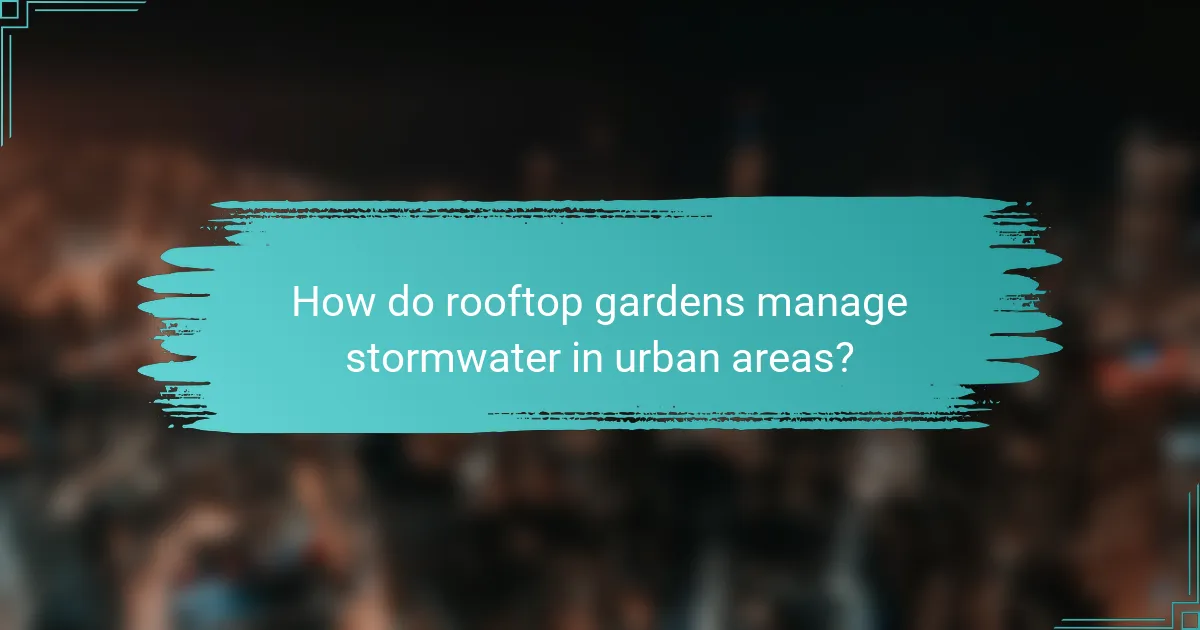Rooftop gardens are an innovative solution for managing stormwater in urban settings, effectively absorbing rainwater and reducing runoff. By acting as natural sponges, they not only mitigate flooding but also contribute to water conservation through rainwater harvesting and enhanced evapotranspiration. These green spaces are essential for promoting sustainable water management in densely populated areas.

How do rooftop gardens manage stormwater in urban areas?
Rooftop gardens effectively manage stormwater in urban areas by absorbing rainwater, reducing runoff, and improving drainage systems. These gardens play a crucial role in mitigating flooding and conserving water resources, making them a valuable asset in densely populated environments.
Absorption of rainwater
Rooftop gardens absorb rainwater through their soil and vegetation, which helps to retain moisture and reduce the volume of water that flows into drainage systems. This absorption can significantly decrease the immediate impact of heavy rainfall, allowing for gradual water release into the environment.
Plants in these gardens not only take up water but also contribute to evapotranspiration, further reducing the amount of water that contributes to stormwater runoff. This process can help maintain a more balanced water cycle in urban settings.
Reduction of runoff
By absorbing and retaining rainwater, rooftop gardens effectively reduce runoff, which is the water that flows over surfaces and can lead to flooding. This reduction is particularly important in urban areas where impervious surfaces dominate, leading to increased runoff during storms.
Implementing a rooftop garden can lower peak runoff rates by up to 50% or more, depending on the design and plant selection. This not only helps prevent flooding but also minimizes the burden on municipal stormwater systems.
Improved drainage systems
Rooftop gardens can enhance existing drainage systems by acting as a buffer that slows down water flow. This allows for better management of stormwater and reduces the risk of system overload during heavy rains.
Incorporating features such as green roofs with drainage layers can further optimize water flow management, ensuring that excess water is directed appropriately and does not contribute to urban flooding.
Use of permeable materials
Utilizing permeable materials in rooftop garden construction allows water to seep through surfaces rather than running off. This can include permeable pavers, gravel, or specially designed soil mixtures that enhance water infiltration.
These materials help maintain moisture levels in the garden while preventing excess water from accumulating and overwhelming drainage systems. Choosing the right permeable materials can significantly improve the garden’s stormwater management capabilities.
Retention basins
Retention basins are designed to hold stormwater temporarily, allowing for controlled release over time. Incorporating these features into rooftop gardens can further enhance their ability to manage stormwater effectively.
These basins can be integrated into the garden’s design, capturing excess rainwater and providing a reservoir for plants to draw from during dry periods. Properly sized retention basins can significantly reduce the risk of flooding while promoting water conservation.

What are the benefits of rooftop gardens for flood mitigation?
Rooftop gardens provide significant advantages for flood mitigation by absorbing rainwater, reducing runoff, and enhancing urban infrastructure resilience. They act as natural sponges, which can help manage stormwater effectively and decrease the likelihood of flooding in urban areas.
Decreased flood risk
Rooftop gardens lower flood risk by capturing and retaining rainwater, which reduces the volume of water that enters drainage systems during heavy rainfall. This absorption helps to prevent overwhelming local waterways and reduces the chances of urban flooding.
For instance, a well-designed rooftop garden can retain up to 75% of rainfall, depending on the plant selection and soil depth. This significant retention can alleviate pressure on municipal drainage systems, especially in densely populated cities.
Enhanced urban resilience
By integrating rooftop gardens into urban planning, cities can enhance their resilience to climate change and extreme weather events. These gardens not only mitigate flooding but also contribute to temperature regulation and improved air quality.
Urban areas with more green spaces, including rooftop gardens, often experience less heat island effect, which can lead to lower energy consumption for cooling. This holistic approach supports sustainable city development and improves the overall quality of life for residents.
Lowered peak flow rates
Rooftop gardens help to lower peak flow rates during storms by delaying the release of stormwater. This delay allows for a more gradual flow into drainage systems, reducing the risk of overflow and subsequent flooding.
In practical terms, a rooftop garden can slow down runoff by several hours, which is crucial during intense rain events. Implementing such systems can be particularly beneficial in areas prone to flash flooding.
Improved water quality
Rooftop gardens contribute to improved water quality by filtering pollutants from rainwater before it reaches the ground or drainage systems. The plants and soil act as natural filters, capturing contaminants and sediments.
This filtration process can significantly reduce the amount of harmful substances entering local waterways, promoting healthier ecosystems. Additionally, the use of native plants in rooftop gardens can further enhance this water quality benefit by supporting local biodiversity.

How do rooftop gardens contribute to water conservation?
Rooftop gardens play a significant role in water conservation by reducing the demand for potable water, utilizing rainwater harvesting, and enhancing evapotranspiration. These gardens can effectively manage stormwater, mitigate flooding, and promote sustainable water use in urban environments.
Reduction in potable water use
Rooftop gardens can significantly lower the need for potable water by providing an alternative source for irrigation. By using native and drought-resistant plants, these gardens require less water, which can lead to savings of up to 50% in water usage compared to traditional landscaping.
Implementing a rooftop garden can also help homeowners and businesses reduce their water bills. In areas where water costs are high, this reduction can lead to substantial financial savings over time.
Utilization of rainwater harvesting
Rooftop gardens can be designed to incorporate rainwater harvesting systems, which collect and store rainwater for irrigation. This practice not only conserves potable water but also reduces runoff, helping to manage stormwater effectively.
Installing a rainwater harvesting system can involve simple components such as gutters, downspouts, and storage tanks. Depending on the size of the rooftop garden, these systems can capture hundreds to thousands of liters of rainwater annually.
Increased evapotranspiration
Evapotranspiration is the process by which water is transferred from the land to the atmosphere through evaporation and plant transpiration. Rooftop gardens enhance this process, which helps to cool the surrounding environment and reduce the urban heat island effect.
By increasing evapotranspiration, rooftop gardens can help manage excess water during heavy rainfall, allowing for better stormwater management. This can be particularly beneficial in urban areas prone to flooding, as it reduces the volume of water that enters drainage systems.

What are the key design considerations for rooftop gardens?
Key design considerations for rooftop gardens include structural load capacity, appropriate plant selection for the local climate, and effective water management systems. Each of these factors plays a crucial role in ensuring the garden’s sustainability and functionality.
Structural load capacity
Assessing the structural load capacity is essential before installing a rooftop garden. The combined weight of soil, plants, and water can be significant, so it’s vital to consult with a structural engineer to ensure the building can support the additional load.
Generally, a rooftop garden may require a load capacity of at least 100-150 kg per square meter, depending on the design and materials used. Buildings with lower load capacities may need lightweight soil alternatives or a reduced planting area.
Plant selection for local climate
Choosing the right plants for a rooftop garden is critical for its success and longevity. Select species that are well-suited to the local climate, considering factors such as temperature, humidity, and sunlight exposure.
For example, in temperate regions, drought-resistant plants like sedums or native grasses can thrive with minimal maintenance. In contrast, tropical areas may benefit from lush, moisture-loving plants that can withstand heavy rainfall.
Water management systems
Implementing effective water management systems is vital to control stormwater runoff and promote water conservation. This can include features like drainage systems, rainwater harvesting, and irrigation methods that minimize water waste.
Consider using permeable materials for pathways and installing a rainwater collection system to irrigate the garden. These practices not only reduce flooding risks but also help maintain healthy plant growth while conserving resources.

What are the costs associated with installing a rooftop garden?
The costs of installing a rooftop garden can vary significantly based on factors such as size, design, and materials used. Generally, homeowners can expect to invest anywhere from a few thousand to tens of thousands of dollars for a complete setup.
Initial installation costs
Initial installation costs for a rooftop garden typically include materials, labor, and any necessary structural modifications. On average, the cost can range from USD 15 to USD 30 per square foot, depending on the complexity of the design and the types of plants selected.
Additional expenses may arise from waterproofing, drainage systems, and soil preparation. It’s crucial to consult with professionals to ensure that the existing roof can support the additional weight and that all local building codes are met.
Homeowners should also consider potential long-term savings from reduced stormwater management fees and improved energy efficiency, which can offset some of the initial investment over time.
